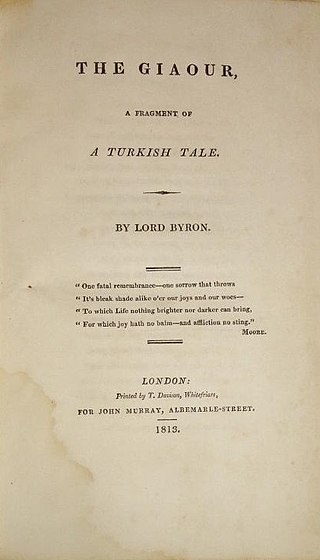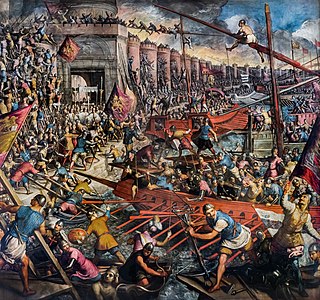
Lara, A Tale, a rhymed tragic narrative poem by Lord Byron, was first published in 1814.

Lara, A Tale, a rhymed tragic narrative poem by Lord Byron, was first published in 1814.
The first work composed after Byron abandoned the idea of giving up writing and buying back his copyrights, it is regarded by critics as a continuation of the autobiographical work begun in The Corsair . [1] Unlike The Corsair, it was published anonymously, in conjunction with Samuel Rogers' Jacqueline. [2]
Lara, A Tale was first published anonymously by Lord Byron in 1814 alongside another poem that was not written by Byron. In this version, there is nothing to distinguish between Lara and Jacqueline (written by Samuel Rogers), as they were published anonymously and without any indication that there are two separate authors within the text. This tragic narrative poem is seen as a continuation of another poem of Byron's, The Corsair. It details Count Lara's return home after spending a few years travelling abroad. With a page as his only company, Lara's story continues as he encounters problems with his fellow men. First, this leads to a duel that Count Lara ends up winning and as the story progresses, he must also fight both friends and foes. Count Lara is successful in his battle against all odds, until one night he encounters a large group and attempts to fight them. Unfortunately, he is mortally wounded in the process and dies at the end of the poem.
The first drafts of the poem are from 1814. The copy text that Byron wrote for the first edition was made between June 14 and June 23, 1814. There were subsequent corrections made but none of the materials have been found. Sometime after August 5, 1814, Lara was published with Jacqueline for the first time. The first three editions were published together and anonymously, selling almost 7,000 copies. When the fourth edition was released, the tale was published by itself and under Byron's name.
The narrative poem recounts the story of the fateful return of Count Lara to his home after spending years abroad traveling the orient. One of Byron's footnotes explains that, even though the name "Lara" is of Spanish origin, "no circumstance of local or national description fix[es] the scene or hero of the poem to any country or age". [3]
The poem is composed of two cantos. In the first, the mysterious count Lara, of ancient lineage, returns to his native country after a long absence in foreign countries. He is accompanied solely by an oriental page, Kaled, who is silently devoted to him. Orphaned in youth (“With none to check, with few to point in time/ The thousand paths that slope the way to crime”), Lara had led a dissolute life at home until leaving abroad while quite young. He returns altered, —reserved, haughty, and apparently palled with pleasure and fame (“That brow in furrowed lines had fixed at last/ And spake of passions, but of passions past”).
On a beautiful moonlit night, Lara's servants are awakened by an unearthly shriek from his hall, and they run in to find the count prostrate unconscious on the floor. Lara is revived by Kaled, who speaks to him in a foreign tongue. Though nothing further occurs, Lara's servants are convinced that he had seen an apparition, and that the shriek was emitted by something inhuman.
Lara attends an evening reception given by count Otho, a local dignitary. While looking on the revelers, he is recognized by Sir Ezzelin, a relative of Otho, who angrily challenges him for unnamed crimes abroad. Otho intervenes, and arranges for the two to meet tomorrow before the local nobles to judge the accusations. Lara agrees, and soon leaves the hall, together with Kaled. Sir Ezzelin leaves not long after.
In the second canto, the nobles are assembled on the morrow in Otho's hall to hear the charges and defense. However, although Lara shows up, Ezzelin does not appear. After an angry exchange, Otho offers to fight Lara in his cousin's stead, and is quickly overpowered by Lara, who spares him at the intercession of the nobles.
Meanwhile, Ezzelin has totally disappeared, never having returned from the evening assembly at Otho's hall; suspicion quickly points at Lara, and the unforgiving Otho incites the rest of the nobility to put Lara on trial. Having foreseen the threat, Lara has cultivated the sympathies of the oppressed peasantry of the country, who are ground underfoot by the haughty and detached nobility. When Otho makes his move, Lara rises in rebellion at the head of the serfs.
After some initial success, Lara's undisciplined rabble get the worst of it; when defeat, desertion, and ambush have reduced Lara's army into a small though faithful band, he resolves to lead them over the border into another country. On the very border, however, they are intercepted, and after a stubborn fight in which Lara almost prevails, he is struck by an arrow, and falls mortally wounded from his horse. As Otho and his allies approach to gloat over Lara's fallen state, the count ignores them and dies while speaking with Kaled in a foreign tongue. When Lara expires, Kaled faints, and is discovered to be a woman in disguise. She refuses to leave Lara's body, and remains living by the tree at which he fell and was buried, until her death.
A postscript relates how a local woodcutter saw Sir Ezzelin's body being thrown in the lake by a masked horseman the night of his disappearance.
This article presents lists of the literary events and publications in 1815.
This article contains information about the literary events and publications of 1814.

Samuel Rogers was an English poet, during his lifetime one of the most celebrated, although his fame has long since been eclipsed by his Romantic colleagues and friends Wordsworth, Coleridge and Byron. His recollections of these and other friends such as Charles James Fox are key sources for information about London artistic and literary life, with which he was intimate, and which he used his wealth to support. He made his money as a banker and was also a discriminating art collector.

"The Knight's Tale" is the first tale from Geoffrey Chaucer's The Canterbury Tales.
Narrative poetry is a form of poetry that tells a story, often using the voices of both a narrator and characters; the entire story is usually written in metered verse. Narrative poems do not need to rhyme. The poems that make up this genre may be short or long, and the story it relates to may be complex. It is normally dramatic, with various characters. Narrative poems include all epic poetry, and the various types of "lay", most ballads, and some idylls, as well as many poems not falling into a distinct type.

The Byronic hero is a variant of the Romantic hero as a type of character, named after the English Romantic poet Lord Byron. Both Byron's own persona as well as characters from his writings are considered to provide defining features to the character type.
This is a chronology of events in the life of George Gordon Byron, 6th Baron Byron. Each year links to its corresponding "year in poetry" article:

The Corsair (1814) is a long tale in verse written by Lord Byron and published by John Murray in London. It was extremely popular, selling ten thousand copies on its first day of sale, and was influential throughout the following century, inspiring operas, music and ballet. The 180-page work was dedicated to Irish poet Thomas Moore.

Childe Harold's Pilgrimage is a long narrative poem in four parts written by Lord Byron. The poem was published between 1812 and 1818. Dedicated to "Ianthe", it describes the travels and reflections of a young man disillusioned with a life of pleasure and revelry and looking for distraction in foreign lands. In a wider sense, it is an expression of the melancholy and disillusionment felt by a generation weary of the wars of the post-Revolutionary and Napoleonic eras. The title comes from the term childe, a medieval title for a young man who was a candidate for knighthood.

The Giaour is a poem by Lord Byron first published in 1813 by John Murray and printed by Thomas Davison. It was the first in the series of Byron's Oriental romances. The Giaour proved to be a great success when published, consolidating Byron's reputation critically and commercially.

Mazeppa is a narrative poem written by the English Romantic poet Lord Byron in 1819. It is based on a popular legend about the early life of Ivan Mazepa (1639–1709), who later became Hetman of Ukraine. Byron's poem was immediately translated into French, where it inspired a series of works in various art forms. The cultural legacy of Mazeppa was revitalised with the independence of Ukraine in 1991.
Nationality words link to articles with information on the nation's poetry or literature.
Nationality words link to articles with information on the nation's poetry or literature.
Events from the year 1814 in the United Kingdom.
Nationality words link to articles with information on the nation's poetry or literature.

George Gordon Byron, 6th Baron Byron was a British poet and peer. He is one of the major figures of the Romantic movement, and is regarded as being among the greatest of English poets. Among his best-known works are the lengthy narratives Don Juan and Childe Harold's Pilgrimage; much of his shorter lyrics in Hebrew Melodies also became popular.

History of a Six Weeks' Tour through a part of France, Switzerland, Germany, and Holland; with Letters Descriptive of a Sail Round the Lake of Geneva and of the Glaciers of Chamouni is a travel narrative by the English Romantic authors Mary Shelley and Percy Bysshe Shelley. Published anonymously in 1817, it describes two trips taken by Mary, Percy, and Mary's stepsister, Claire Clairmont: one across Europe in 1814, and one to Lake Geneva in 1816. Divided into three sections, the text consists of a journal, four letters, and Percy Shelley's poem "Mont Blanc". Apart from the poem, preface, and two letters, the text was primarily written and organised by Mary Shelley. In 1840 she revised the journal and the letters, republishing them in a collection of Percy Shelley's writings.

The Siege of Corinth is a rhymed, tragic narrative poem by Lord Byron. Published in 1816 by John Murray in London with the poem Parisina, it was inspired by the Ottoman massacre of the Venetian garrison holding the Acrocorinth in 1715 – an incident in the Ottoman reconquest of the Morea during the Ottoman-Venetian Wars.

The Bride of Abydos is a poem written by Lord Byron in 1813. One of his earlier works, The Bride of Abydos is considered to be one of his "Heroic Poems", along with The Giaour, Lara, The Siege of Corinth, The Corsair and Parisina. These poems contributed to his poetic fame at the time in England.
Robert Charles Dallas was a Jamaican-born British poet and conservative writer. He is known also for a contentious book on Lord Byron, and a history of the Second Maroon War.